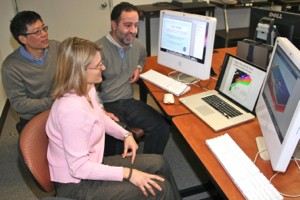Researchers meet at VIMS to refine carbon budget for U.S. East Coast
A group of 35 researchers from institutions all along the eastern seaboard gathered at the Virginia Institute of Marine Science last week to further integrate and refine field measurements and computer models of carbon cycling in the waters along the U.S. East Coast.
An understanding of the behavior and fate of carbon within the ocean, including its productive coastal area, is needed to most accurately predict the rate and magnitude of global warming and to effectively plan for climate-change impacts such as sea-level rise and increasing ocean acidity.
 The "U.S. East Coast
Carbon Cycle Synthesis Workshop," coordinated by the North American Carbon Program and the national Ocean Carbon and
Biogeochemistry program, was
organized and led by VIMS professor Marjy Friedrichs, Dr. Raymond Najjar of the
Pennsylvania State University, and Dr. Wei-Jun Cai of the University of
Georgia. The workshop was sponsored by NASA and the National Science Foundation.
The "U.S. East Coast
Carbon Cycle Synthesis Workshop," coordinated by the North American Carbon Program and the national Ocean Carbon and
Biogeochemistry program, was
organized and led by VIMS professor Marjy Friedrichs, Dr. Raymond Najjar of the
Pennsylvania State University, and Dr. Wei-Jun Cai of the University of
Georgia. The workshop was sponsored by NASA and the National Science Foundation.
The workshop’s goal, says Friedrichs, was to “further quantify the carbon budget along the U.S. East Coast by synthesizing observations and modeling results from the many different groups that are working on the issue.” Researchers from nearly 20 different institutions from Maine to Florida took part in the two-day meeting.
Participants will use the knowledge gained during the workshop to guide and coordinate future research and modeling efforts, with the ultimate goal of creating a single integrated carbon budget for the East Coast that best represents the flow of carbon within and between the many different components of the coastal zone—including estuaries such as Chesapeake Bay, rivers, tidal wetlands, coastal waters, seafloor sediments, the atmosphere, and living organisms. The study is part of a larger effort to understand the carbon balance of North America and adjacent oceans, which play a key role in the global carbon cycle.
Interest in the carbon budget of the coastal ocean stems from the recognition that it likely plays a significant role in the global carbon cycle, but remains poorly studied relative to other ocean and terrestrial ecosystems.
“Although it covers a relatively small area,” says Friedrichs, “the coastal ocean is a highly productive ecosystem with much greater carbon fluxes than the open ocean. It’s also directly influenced by human activities such as nutrient pollution, fishing, dredging, shoreline armoring, levee construction, and dam building.”
The workshop was successful because a diverse group of scientists came together to share specialized knowledge about the different parts of the East Coast’s carbon cycle. “What we found at the workshop,” says Najjar, “is that there are many scientists with a lot of data and knowledge about individual parts of the carbon cycle of the U.S. East Coast. However, until now, that knowledge had not been well integrated to form a big picture of how carbon flows in the region.”
General scientific interest in the carbon cycle stems from concerns about increasing atmospheric levels of carbon dioxide and other greenhouse gases. In 2010, humans released 33.5 billion tons of carbon dioxide to the atmosphere through the burning of fossil fuels and other activities, while atmospheric levels of the gas rose to 391 parts per million, an increase of nearly 25% over the last 50 years. About a quarter of the carbon released to the atmosphere currently ends up in the ocean.


